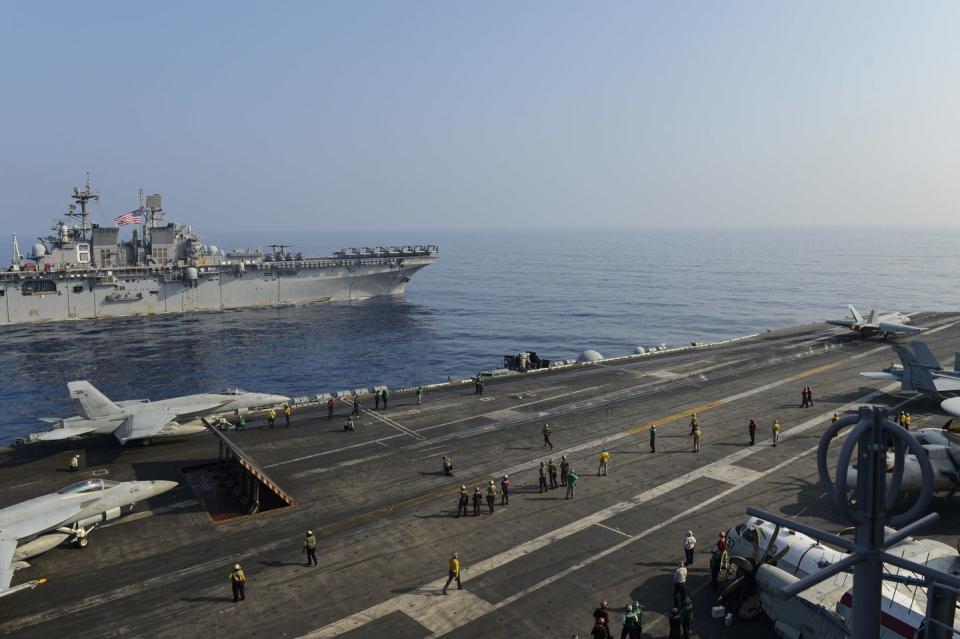U.S. and Chinese Carriers Are Both Sailing in the South China Sea. That's Strange.
U.S. and Chinese aircraft carriers are both operating in the South China Sea.
This is likely the first time carriers from both countries have sailed in the same region.
The U.S. Navy also published—and then deleted—a photo of the destroyer USS Mustin following the Chinese carrier Liaoning.
For what may well be the very first time, the U.S. and the People’s Republic of China are both operating aircraft carriers in the South China Sea.
➡ You love badass ships. So do we. Let’s nerd out over them together.
On April 4, the U.S. Navy’s USS Theodore Roosevelt and the People’s Liberation Army Navy’s Liaoning were both sailing in the sea accompanied by escort ships. At the same time, the U.S. Navy uploaded a photo of the destroyer USS Mustin sailing near the Chinese carrier, with the ship’s commanders looking on.
The USS Theodore Roosevelt Carrier Strike Group was active in the southern half of the South China Sea, exercising with the Royal Malaysian Air Force. This U.S. Navy video shows F/A-18E/F Super Hornet fighters flying alongside RMAF Russian-made Su-30 fighters, and a single RMAF F/A-18D two-seat Hornet fighter. The mixed formation of jets overflies the guided missile cruiser USS Bunker Hill and the carrier USS Roosevelt.
The Navy says the Roosevelt Carrier Strike Group will exercise with forces from Australia, India, Japan, Malaysia and South Korea during the current deployment, describing the operations as “routine.” The guided missile destroyer USS Russell rounds out the three-ship strike group on the surface, and a nuclear-powered attack submarine is likely sailing under the surface to screen for subsea threats.

Another U.S. Navy task force, the Makin Island Amphibious Ready Group (ARG), is also in the South China Sea. The ARG, centered around the amphibious assault ship USS Makin Island, is carrying F-35B Joint Strike Fighters; MV-22 Osprey tiltrotor aircraft; and the rest of the 15th Marine Expeditionary Unit, a battalion-sized Marine Corps unit capable of air, land, and sea operations. The Roosevelt CSG and Makin Island ARG teamed up on April 9 to practice as an even larger Expeditionary Strike Force.
Combined, Theodore Roosevelt and Makin Island operate a total of about 50 fighter jets, including 40-44 F/A-18E/F Super Hornets and six F-35B Joint Strike Fighters.
#OSINT #SouthChinaSea #ChineseNavy #USNavy Heading West through the Luzon Strait is part of the Laioning carrier strike group, the Type 055 Renhai class and one Type 052D Luyang III class aren't with the group. A J-15 Flying Shark can be seen just taking off from Laioning. pic.twitter.com/KlF7Ul16tO
— OSINT-1 (@OSINT_1) April 10, 2021
Meanwhile, a Chinese carrier strike group centered around Liaoning operated farther north in the South China Sea. As the satellite images above show, the strike group consisted of Liaoning, a Type 052D guided missile destroyer, a Type 054A frigate, and a Type 901 replenishment ship. A new Type 055 guided missile cruiser (the largest surface combatant in Asia) and another Type 052C/D destroyer were previously sailing with the Liaoning group, but broke off at some point.
The satellite imagery also picked up the guides missile destroyer USS Mustin, which was shadowing the carrier group, sailing nearby and keeping pace with the Chinese ships. Mustin, an Arleigh Burke-class destroyer built after the end of the Cold War, ironically wasn’t designed to carry anti-ship missiles. It will probably carry the Navy’s new Tomahawk Block V anti-ship cruise missile in the near future.
Very unusual image of the commanding officer and executive officer of #destroyer USS #MUSTIN DDG89 as they shadow #Chinese #carrier #LIAONING 16 in the Philippine Sea on 4 April. US #Navy rarely acknowledges both its efforts to shadow Chinese ships and Chinese shadowing US ships pic.twitter.com/2tv4GF7XIO
— Chris Cavas (@CavasShips) April 11, 2021
The photo shows the Mustin’s commanding officer and executive officer casually looking on while sailing off Liaoning’s starboard quarter—the opposite side the ship is sailing on in the satellite image. The U.S. Navy uploaded the Mustin photo to the Pentagon’s Defense Visual Information Service, but deleted after it went viral on Twitter.
There are some photos that come to define the beginning of an era, and the Mustin photo has that feel. It perfectly encapsulates this moment in time as the U.S. Navy, and the rest of the western world, looks on as China’s military continues its meteoric rise. Liaoning, China’s first carrier, is an excellent example of that.
Hopefully, the era will continue to see the U.S. and Chinese navies sailing alongside—and not toward—each other.
🎥 Now Watch This:
You Might Also Like

